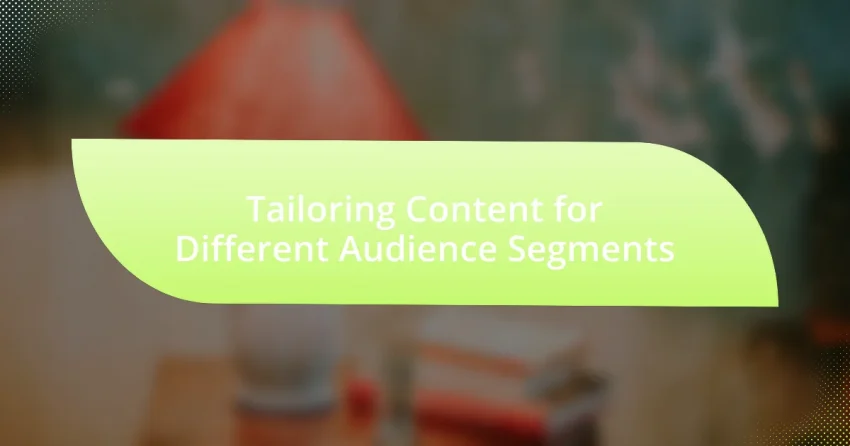Tailoring content for different audience segments involves customizing messages and formats to align with the specific needs, preferences, and behaviors of distinct groups within a target audience. This process is essential for enhancing engagement and relevance, as personalized content has been shown to significantly increase interaction rates and conversion outcomes. Key components of audience segmentation include demographic, psychographic, geographic, and behavioral factors, which collectively inform effective content strategies. The article also addresses the risks of generic content, the importance of utilizing analytics and feedback for continuous improvement, and best practices for avoiding common pitfalls in content tailoring.

What does Tailoring Content for Different Audience Segments entail?
Tailoring content for different audience segments entails customizing messages and formats to meet the specific needs, preferences, and behaviors of distinct groups within a target audience. This process involves analyzing demographic data, psychographics, and user behavior to create relevant content that resonates with each segment. For instance, a study by the Content Marketing Institute found that 72% of marketers believe that personalized content increases engagement, highlighting the effectiveness of tailored messaging. By segmenting audiences based on factors such as age, interests, and purchasing behavior, marketers can enhance relevance and improve overall communication effectiveness.
Why is it important to tailor content for different audience segments?
Tailoring content for different audience segments is crucial because it enhances engagement and relevance. When content is customized to meet the specific needs, preferences, and behaviors of distinct groups, it increases the likelihood of capturing their attention and fostering a connection. Research indicates that personalized marketing can lead to a 20% increase in sales (McKinsey & Company). This demonstrates that understanding audience segments allows for more effective communication strategies, ultimately driving better results in marketing efforts.
How does audience segmentation impact content effectiveness?
Audience segmentation significantly enhances content effectiveness by allowing marketers to tailor messages to specific groups based on demographics, interests, and behaviors. This targeted approach increases engagement, as content resonates more with the audience’s unique preferences and needs. For instance, a study by HubSpot found that personalized content can lead to a 20% increase in sales opportunities. By understanding and addressing the distinct characteristics of each segment, brands can create more relevant and compelling content, ultimately driving higher conversion rates and customer loyalty.
What are the risks of not tailoring content?
Not tailoring content poses significant risks, including decreased audience engagement and reduced conversion rates. When content is generic, it fails to resonate with specific audience segments, leading to a lack of interest and interaction. Research indicates that personalized content can increase engagement rates by up to 202%, highlighting the importance of customization. Additionally, businesses that do not tailor their messaging may experience a 10% drop in conversion rates, as potential customers are less likely to respond to irrelevant information. Therefore, the absence of tailored content can directly impact a brand’s effectiveness in reaching and influencing its target audience.
What are the key components of audience segmentation?
The key components of audience segmentation include demographic, psychographic, geographic, and behavioral factors. Demographic segmentation involves categorizing audiences based on age, gender, income, education, and occupation, which helps in understanding the basic characteristics of the target market. Psychographic segmentation focuses on the values, interests, lifestyles, and personality traits of individuals, providing deeper insights into consumer motivations. Geographic segmentation divides audiences based on location, which can influence preferences and purchasing behavior due to cultural or regional differences. Behavioral segmentation analyzes consumer behaviors, such as purchasing patterns and brand loyalty, allowing marketers to tailor strategies effectively. These components collectively enable businesses to create targeted marketing strategies that resonate with specific audience segments, enhancing engagement and conversion rates.
How do demographics influence content tailoring?
Demographics significantly influence content tailoring by determining the preferences, interests, and behaviors of different audience segments. For instance, age demographics can dictate the type of language, imagery, and topics that resonate with a specific group; younger audiences may prefer informal language and trending topics, while older demographics might favor more formal communication and traditional subjects. Additionally, gender demographics can affect content themes, with studies showing that women and men often engage with different types of content, such as lifestyle versus technology. Furthermore, cultural background influences content preferences, as diverse cultural groups may respond better to culturally relevant references and narratives. Research indicates that personalized content based on demographic data can increase engagement rates by up to 50%, highlighting the importance of tailoring content to meet the specific needs and expectations of various demographic segments.
What role does psychographics play in audience segmentation?
Psychographics play a crucial role in audience segmentation by providing insights into the attitudes, values, interests, and lifestyles of consumers. This deeper understanding allows marketers to create more targeted and relevant content that resonates with specific audience segments. For instance, research by the American Marketing Association indicates that psychographic segmentation can lead to a 20% increase in marketing effectiveness, as it enables brands to align their messaging with the emotional and psychological drivers of their target audience. By leveraging psychographics, businesses can enhance engagement and improve conversion rates, ultimately leading to more successful marketing strategies.

How can content be tailored for specific audience segments?
Content can be tailored for specific audience segments by analyzing demographic data, preferences, and behaviors to create relevant and engaging material. This involves segmenting the audience based on factors such as age, gender, location, interests, and purchasing behavior. For instance, a study by the Content Marketing Institute found that 72% of marketers believe that personalized content increases engagement, demonstrating the effectiveness of targeted messaging. By utilizing tools like surveys, analytics, and social media insights, content creators can refine their strategies to meet the unique needs of each segment, ensuring higher relevance and impact.
What strategies can be employed to tailor content effectively?
To tailor content effectively, employ strategies such as audience segmentation, personalization, and utilizing data analytics. Audience segmentation involves categorizing your audience based on demographics, interests, and behaviors, allowing for targeted messaging that resonates with specific groups. Personalization enhances engagement by customizing content to individual preferences, which studies show can increase conversion rates by up to 20%. Utilizing data analytics helps in understanding audience interactions and preferences, enabling continuous improvement of content strategies. For instance, a report by HubSpot indicates that personalized content can lead to a 42% higher response rate.
How can personalization enhance audience engagement?
Personalization enhances audience engagement by delivering tailored content that resonates with individual preferences and behaviors. When content is customized based on user data, such as browsing history or demographic information, it increases relevance, leading to higher interaction rates. For instance, a study by Epsilon found that 80% of consumers are more likely to make a purchase when brands offer personalized experiences. This indicates that personalization not only captures attention but also drives conversion, as users feel more connected to content that reflects their interests and needs.
What tools are available for content customization?
Tools available for content customization include content management systems (CMS) like WordPress and Drupal, personalization platforms such as Optimizely and Dynamic Yield, and marketing automation tools like HubSpot and Marketo. These tools enable users to tailor content based on audience behavior, preferences, and demographics, enhancing engagement and relevance. For instance, Optimizely allows A/B testing to determine which content resonates best with specific audience segments, while HubSpot offers features for segmenting email lists and personalizing content delivery.
What types of content resonate with different audience segments?
Different audience segments resonate with various types of content based on their preferences, demographics, and interests. For instance, younger audiences often engage more with video content and interactive formats, while older demographics may prefer informative articles and newsletters. Research by the Content Marketing Institute indicates that 70% of millennials favor video content, while 60% of baby boomers prefer written articles. Additionally, niche audiences, such as hobbyists or professionals, respond well to specialized content that addresses their specific needs, such as how-to guides or industry reports. This segmentation allows marketers to tailor their content strategies effectively, ensuring higher engagement and relevance.
How do preferences vary across different age groups?
Preferences vary significantly across different age groups due to varying life experiences, cultural influences, and developmental stages. For instance, younger age groups, such as teenagers and young adults, often prefer content that is fast-paced, visually engaging, and interactive, reflecting their familiarity with digital technology and social media. In contrast, middle-aged individuals may favor content that is informative and practical, often seeking depth and relevance to their personal or professional lives. Older adults typically prefer content that is straightforward and easy to understand, valuing clarity and accessibility. Research by the Pew Research Center indicates that 90% of adults aged 18-29 use social media, while only 40% of those aged 65 and older do, highlighting the stark differences in platform preferences. Additionally, studies show that preferences for content types, such as video versus text, also vary, with younger audiences gravitating towards video content, while older demographics often prefer written articles.
What content formats are most effective for various segments?
Video content is most effective for younger audiences, while long-form articles resonate better with professionals seeking in-depth information. Research indicates that 54% of consumers prefer video content, particularly among the 18-34 age group, due to its engaging nature. Conversely, a study by the Content Marketing Institute found that 70% of B2B marketers prioritize long-form content for its ability to establish authority and provide comprehensive insights. Infographics are also highly effective across various segments, as they simplify complex information and are shareable, appealing to both visual learners and social media users.

What are the best practices for tailoring content for different audience segments?
The best practices for tailoring content for different audience segments include understanding audience demographics, preferences, and behaviors, and then customizing content accordingly. Research shows that personalized content can increase engagement rates by up to 74%, highlighting the importance of segmentation. Utilizing data analytics tools allows marketers to gather insights on audience interests and interactions, enabling the creation of targeted messaging that resonates with specific groups. Additionally, employing A/B testing can help refine content strategies by comparing the effectiveness of different approaches on various segments.
How can feedback be utilized to improve content tailoring?
Feedback can be utilized to improve content tailoring by systematically analyzing audience responses to refine messaging and delivery. By collecting data through surveys, comments, and engagement metrics, content creators can identify what resonates with specific audience segments. For instance, a study by the Content Marketing Institute found that 70% of marketers who use audience feedback report improved content effectiveness. This data-driven approach allows for adjustments in tone, style, and topics, ensuring that content aligns more closely with audience preferences and needs.
What methods can be used to gather audience feedback?
Surveys and questionnaires are effective methods to gather audience feedback. These tools allow organizations to collect quantitative and qualitative data directly from their audience, enabling them to understand preferences, opinions, and satisfaction levels. According to a study by SurveyMonkey, 90% of respondents prefer surveys for providing feedback, highlighting their effectiveness in engaging audiences. Other methods include focus groups, which facilitate in-depth discussions and insights, and social media polls, which provide real-time feedback from a broader audience. Each method serves to enhance understanding of audience needs, ultimately aiding in the tailoring of content for different segments.
How can analytics inform content adjustments?
Analytics can inform content adjustments by providing data-driven insights into audience behavior and preferences. By analyzing metrics such as engagement rates, click-through rates, and demographic information, content creators can identify which topics resonate with specific audience segments. For instance, a study by HubSpot found that personalized content can lead to a 20% increase in sales, demonstrating the effectiveness of tailoring content based on analytics. This data allows for targeted modifications, ensuring that content aligns with the interests and needs of different audience segments, ultimately enhancing user experience and engagement.
What common mistakes should be avoided in content tailoring?
Common mistakes to avoid in content tailoring include failing to understand the target audience, using overly complex language, and neglecting to personalize content. Understanding the target audience is crucial; without this knowledge, content may not resonate or meet the audience’s needs. Research shows that 70% of consumers prefer personalized content, indicating that neglecting personalization can lead to disengagement. Additionally, using overly complex language can alienate readers, as studies indicate that clear and concise communication increases comprehension and retention. Lastly, not adapting content to different platforms can result in missed opportunities, as each platform has unique audience expectations and engagement styles.
How can over-segmentation hinder content effectiveness?
Over-segmentation can hinder content effectiveness by creating overly narrow audience segments that limit the reach and impact of the content. When content is tailored too specifically, it may fail to resonate with a broader audience, resulting in missed opportunities for engagement and conversion. For instance, a study by HubSpot found that overly segmented email campaigns can lead to lower open rates, as recipients may not find the content relevant to their needs or interests. This indicates that while segmentation is essential for targeting, excessive segmentation can dilute the message and reduce overall effectiveness.
What are the pitfalls of ignoring audience diversity?
Ignoring audience diversity leads to ineffective communication and missed opportunities for engagement. When content fails to resonate with varied demographic groups, it can alienate potential customers, resulting in decreased brand loyalty and reduced market reach. Research indicates that companies embracing diversity in their marketing strategies see a 19% increase in revenue, highlighting the financial implications of neglecting diverse audiences. Additionally, overlooking cultural differences can lead to misinterpretations and negative perceptions, damaging a brand’s reputation. Therefore, recognizing and addressing audience diversity is crucial for effective content strategy and overall business success.
What practical tips can enhance content tailoring for different audience segments?
To enhance content tailoring for different audience segments, utilize audience personas to guide content creation. Audience personas, which are detailed profiles representing specific segments, help in understanding the preferences, behaviors, and needs of each group. By analyzing demographic data, psychographics, and user behavior, marketers can create targeted content that resonates with each segment. For instance, a study by HubSpot found that personalized content can increase engagement rates by up to 202%. Additionally, employing A/B testing allows for the optimization of content based on real-time feedback from different audience segments, ensuring that the messaging is effective and relevant.
